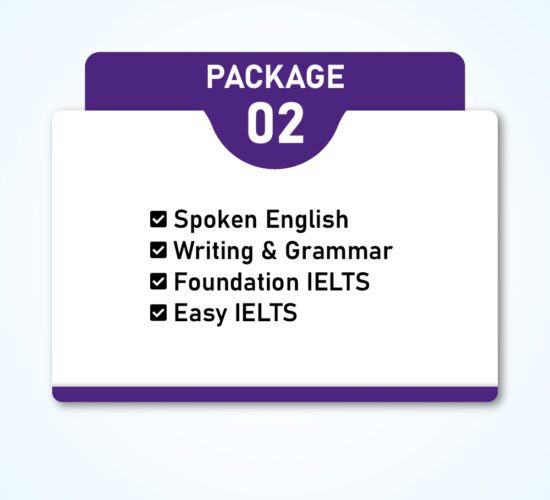Want to improve your English skills from the ground up? Our Complete English Mastery Package is designed to help you excel in every aspect of English learning! This all-in-one course covers Spoken English, Writing & Grammar, and Foundation & Easy IELTS, ensuring you build strong communication skills, master grammar rules, and prepare effectively for IELTS. Whether you’re a beginner or looking to refine your skills, this course will guide you step by step towards fluency and confidence. Join now and start your journey to mastering English

Please fill out the form with accurate details to complete your enrollment. Once you submit the form, our team will review your information and provide further instructions regarding course access and schedule.
| Module 1: Fundamentals of Spoken English | |
| 1.Introduction to Spoken English | Overview of the course, importance of spoken English, and basic guidelines. |
| 2.Greetings and Introductions | Formal and informal greetings; self-introduction for different contexts. |
| 3.Basic Sentence Structure | Subject-Verb-Object structure with practical examples. |
| 4.Nouns | Types of nouns and their usage in daily conversations. |
| 5.Pronunciation Techniques | Common pronunciation challenges and tips for clarity. |
| 6.Verbs | Action, state, and linking verbs with examples. |
| 7.Adjectives | Types of adjectives and their order in sentences. |
| 8.Adverbs | Using adverbs to modify verbs and adjectives effectively. |
| 9.Degrees of Comparison | Positive, comparative, and superlative degrees with practical usage. |
| 10.Tenses: Present Simple | Usage of present simple tense in daily conversations. |
| 11.Tenses: Past Simple | Sharing past experiences using past simple tense. |
| 12.Tenses: Future Simple | Talking about future plans using future simple tense. |
| Midterm Exam | Covers all topics from Classes 1–12. |
| Module 2: Everyday Conversations and Speech Skills | |
| 13.Phonetics and Sounds | Common English sounds and their correct pronunciation. |
| 14.Homophones and Common Confusions | Differentiating between similar-sounding words. |
| 15.Talking About Past Experiences | Sharing personal stories with appropriate vocabulary and tenses. |
| 16.Describing People and Places | Vocabulary and phrases to describe appearances, personalities, and locations. |
| 17.Small Talk | Techniques for initiating, maintaining, and ending small talk. |
| 18.Shopping Conversations | Vocabulary and phrases for shopping and bargaining scenarios. |
| 19.Restaurant Conversations | Ordering food and interacting with restaurant staff. |
| 20.Public Speaking Basics | Techniques to speak confidently in public with examples. |
| 21.Movie or Show-Based Class | Watching a clip, noting vocabulary, and discussing themes. |
| Final Exam | Covers all topics from Classes 13–21. |
| Module 3: Advanced Communication Techniques | |
| 22.Using Connectors in Speech | Linking ideas using connectors like and, but, so, because. |
| 23.Prepositions | Commonly used prepositions in spoken English with examples. |
| 24.Modals for Polite Speech | Using modals like could, would, and might for requests and offers. |
| 25.Narrating Events | Structuring narratives for storytelling and sharing experiences. |
| 26.Voice | Basic changes of voice. |
| 27.Common Mispronunciations | Correcting pronunciation errors and improving clarity. |
| 28.Phonetics Practice | Focused practice on challenging sounds with real-life examples. |
| 29.Group Discussions | Collaborative discussions on varied topics to build confidence. |
| 30.Course Recap and Feedback | Summary of key lessons, student presentations, and feedback session. |
| 1. Essential grammar for writing | |
| 1 | Parts of Speech: Nouns, Verbs, Adjectives, Adverbs. |
| 2 | Introduction to Tenses |
| 3 | state verbs. |
| 4 | Subject-Verb Agreement |
| 5 | Articles (A, An, The) |
| 6 | Prepositions. |
| 7 | Modals and Modal Phrases. |
| 8 | Passive Voice vs. Active Voice. |
| 9 | Relative Clauses (Who, Which, That, Where) |
| 10 | Punctuation, connectors |
| Action verb/ helping verb, use of modals | |
| 2. Writing- sentence formation | |
| 11 | Simple Sentence Structure and Types |
| 12 | Compound Sentences and Coordinating Conjunctions |
| 13 | Complex Sentences with Subordinating Conjunctions |
| 14 | Sentence Variety for Cohesion |
| 15 | Modifiers for Sentence Expansion (Adjectives, Adverbs, and Phrases) |
| 16 | Avoiding Run-on Sentences and Sentence Fragments |
| 3. Writing- developing paragraphs | |
| 17 | Paragraph Structure and Topic Sentences |
| 18 | Supporting Sentences and Details |
| 19 | Coherence and Transition Words |
| 20 | Concluding Sentences and Writing Complete Paragraphs |
| 4. Writing – Essay | |
| 21 | Understanding Essay Structure |
| 22 | Outlining and Planning Your Essay |
| 23 | Writing Effective Body Paragraphs |
| 24 | Concluding an Essay and Editing for Clarity |
| 1. Intruduction | 1. IELTS Test Structure( Listening, Reading, Writing, Speaking ) | |
| 2. Listening Module | 2. Developing Strategies for Understanding Native Spoken English | |
| 3. Recognizing Key Information ( Keyword and Phrases ) | ||
| 4. Easy Listening Practice | ||
| 3. Reading Module | 5. Developing Techniques for Effective Reading | |
| 6. Recognizing how to do- Skimming, Scanning, Identifying Topic Sentences and Examples | ||
| 7. Easy Reading Practice | ||
| 4.Writing Module | 8. Guided Approach for Approaching Writing Task 1 & Task 2 | |
| 9. Developing Written Grammar ( Active and Passive Sentences, Complex Sentences ) | ||
| 10. Generating Ideas and Working on Task Analysis and Response Structure | ||
| 5. Speaking Module | 11. Responding to Questions and Answering with Reasons | |
| 12. Learning how to Express Ideas | ||
| 6. Grammar Fundamentals | 13. Emphasis on Tense | |
| 14. Subject-Verb Agreement | ||
| 15. Prepositions | ||
| 16. Adverbs and Adjectives ( for Writing and Speaking ) | ||
| 7. Vocabulary Building | 17. Situation-Based Vocabulary ( Reading, Writing and Speaking) | |
| 8. Essential Resources (Foundation IELTS) | Mindset for IELTS (Foundation + 1 + 2) | |
| Practical Faster Reading | ||
| Common Mistakes at IELTS | ||
| 1. Reading Module |
1.Introduction to the Reading module, question types, test format True/False/Not Given – Yes/No/Not Given |
|
| 2. Completing Notes + Table + Sentence Completion | ||
| >3. Matching Heading | ||
| 4. Matching Information + Statement Matching | ||
| 5. MCQ | ||
| 6. Summary Completion – With Clue / Without Clue | ||
| 7. General Training Passages | ||
|
8. Labelling Diagram + Sentence Ending Matching + Short Questions |
||
| 9. Overview + Class Test | ||
| 10. Full Test + Feedback | ||
| 2. Writing Module |
1.Task 1 – Overview of Task Types and Structure Writing an Introduction and Overview (AC) Understanding Different Types of Letters (GT) |
|
| 2.Task 1 – Bar Chart + Line Graph (AC) Formal Letter (GT) | ||
| 3.Task 1 – Pie Chart + Table (AC) Informal Letter (GT) | ||
| 4.Task 1 – Process Diagram + Maps (AC) | ||
| 5.Task 1 – Overview and class test + Feedback | ||
|
6.Task 2 – Overview of Task Types and Structure + Introduction Writing |
||
| 7.Task 2 – Agree/Disagree / Opinion based Essays Developing Cohesive Body Paragraphs (PEEL Method) | ||
| 8.Task 2 – Discuss Both Views + Advantage/Disadvantage | ||
| 9.Task 2 – Two-part Question + Problem/Cause – Solution | ||
| 10.Task 2 – Overview and class test + Feedback | ||
| 3. Listening Module |
1.Introduction to the Listening module, question types, test format Part 1 – Completing Notes / Table / Sentences |
|
| 2.Part 2 – Maps + MCQ | ||
| 3.Part 2 / 3 – MCQ | ||
| 4.Part 2 / 3 – Matching + Gaps | ||
| 5.Part 4 – Completing Notes + class test | ||
| 6.Overview and full test | ||
| 4. Speaking Module | 1.Introduction to the Speaking module, question types, test format Part 1 – Q. Topics, Answer Format (PEARL Method) | |
| 2.Part 1 – Pair Practice | ||
| 3.Part 2 – Question categories and Answer Format | ||
| 4.Part 2 – Individual practice | ||
| 5.Part 3 – Q. types & Answer Format (CORE Method + 321 method) | ||
| 6.Part 3 – Individual & Pair practice | ||
WhatsApp us

